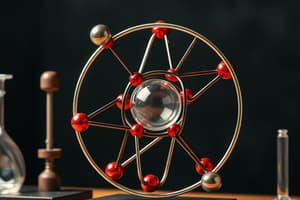Podcast
Questions and Answers
What types of elements primarily make up inorganic compounds?
What types of elements primarily make up inorganic compounds?
- Elements from the s, p, and d blocks of the periodic table (correct)
- Elements from the d and f blocks of the periodic table
- Elements containing carbon
- Elements from the f block of the periodic table
In inorganic chemistry, what is the fundamental force that binds atoms together in molecules?
In inorganic chemistry, what is the fundamental force that binds atoms together in molecules?
- Ionic bonding
- Metallic bonding
- Van der Waals forces
- Covalent bonding (correct)
Which type of bonding involves the sharing of electrons between two atoms?
Which type of bonding involves the sharing of electrons between two atoms?
- Ionic bonding
- Metallic bonding
- Hydrogen bonding
- Covalent bonding (correct)
What is the primary characteristic of metallic bonding?
What is the primary characteristic of metallic bonding?
How are ions held together in ionic compounds?
How are ions held together in ionic compounds?
Which category of inorganic compounds involves the formation of molecular substances through electron sharing?
Which category of inorganic compounds involves the formation of molecular substances through electron sharing?
What distinguishes molecular inorganic compounds from other compounds?
What distinguishes molecular inorganic compounds from other compounds?
Which type of compound contains central metal atoms surrounded by ligands?
Which type of compound contains central metal atoms surrounded by ligands?
What is the critical application of ionic compounds like potassium nitrate (KNO3)?
What is the critical application of ionic compounds like potassium nitrate (KNO3)?
Which analytical method provides information about an element's atomic arrangement and molecular weight?
Which analytical method provides information about an element's atomic arrangement and molecular weight?
What is the purpose of using coordination compounds as catalysts?
What is the purpose of using coordination compounds as catalysts?
Which technique provides information about the thermal properties and transitions of inorganic compounds?
Which technique provides information about the thermal properties and transitions of inorganic compounds?
Flashcards are hidden until you start studying
Study Notes
Exploring the World of Inorganic Chemistry
Inorganic chemistry is a fascinating field that delves into the intricacies of elements and compounds without carbon. It encompasses a vast array of substances, from the essential elements that form the building blocks of life to the more exotic materials that push the boundaries of human innovation. Let's dive into some of the key concepts and discoveries in inorganic chemistry.
Atomic Structure and Bonding
At the foundation of inorganic chemistry lies the understanding of atomic structure and the forces that bind atoms together in molecules. Inorganic compounds are composed primarily of elements from the s, p, and d blocks of the periodic table, which encompasses the elements that do not contain carbon.
The types of bonding we find in inorganic chemistry include:
- Covalent bonding: Electrons are shared between two atoms.
- Ionic bonding: Electrons are transferred between atoms, creating anions and cations.
- Metallic bonding: Electrons are delocalized within a lattice structure.
Classification of Inorganic Compounds
Inorganic compounds can be broadly classified into the following categories:
- Ions and ionic compounds: These involve the transfer of electrons to form charged particles called ions, which are held together by electrostatic forces.
- Covalent compounds: These involve the sharing of electrons between atoms, resulting in the formation of molecular substances.
- Molecular inorganic compounds: These are compounds that contain only elements from the s and p blocks, like NH3 (ammonia) and H2O (water).
- Coordination compounds and complexes: These are compounds containing central metal atoms surrounded by ligands that can be ions or molecules.
Important Inorganic Compounds and Their Applications
Numerous inorganic compounds have found critical applications in various fields:
- Ionic compounds: These are widely used as fertilizers (like potassium nitrate, KNO3), disinfectants (like sodium hypochlorite, NaOCl), and as electrolytes in batteries and other electrical devices.
- Covalent compounds: These include essential elements like oxygen (O2) and nitrogen (N2), and compounds like ammonia (NH3), which is a crucial precursor to fertilizers and explosives.
- Coordination compounds: These are used as catalysts in various chemical reactions, as well as in the production of dyes and pigments.
- Metallurgical compounds: These are used in the extraction and refinement of metals, as well as in metallurgy and materials science.
Analytical Methods and Techniques
Inorganic chemistry also encompasses a range of analytical methods and techniques, which are used to determine the composition and properties of inorganic compounds:
- Spectroscopy: This includes techniques like X-ray diffraction (XRD), infrared spectroscopy (IR), Raman spectroscopy, and mass spectrometry (MS), which provide information about an element's atomic arrangement, vibrational modes, and molecular weight.
- Chromatography: This is a separation technique that separates compounds based on their differences in solubility, adsorption, or other properties, such as gas chromatography (GC) and high-performance liquid chromatography (HPLC).
- Thermal analysis: This includes techniques like differential scanning calorimetry (DSC) and thermogravimetric analysis (TGA), which provide information about the thermal properties and transitions of inorganic compounds.
Conclusion
Inorganic chemistry is a vast and dynamic field, with its discoveries constantly shaping the world around us. From the essential elements that form the building blocks of life to the exotic materials that push the boundaries of human innovation, inorganic chemistry has a profound impact on our daily lives. And as our understanding of the behavior of inorganic compounds continues to expand, so too will our ability to harness these materials to address the challenges of tomorrow.
Studying That Suits You
Use AI to generate personalized quizzes and flashcards to suit your learning preferences.




